|
Related FAQs: Dendrophylliids, Dendrophylliids 2, Dendrophylliid Identification, Dendrophylliid Behavior, Dendrophylliid Compatibility, Dendrophylliid Selection, Dendrophylliid Systems, Dendrophylliid Feeding, Dendrophylliid Disease, Dendrophylliid Reproduction, Stony/True Coral, Coral System Set-Up, Coral System Lighting, Stony Coral Identification, Stony Coral Selection, Coral Placement, Foods/Feeding/Nutrition, Disease/Health, Propagation, Growing Reef Corals, Stony Coral Behavior,
Related Articles: Large Polyp Stony
Corals, Stony or True Corals,
Order Scleractinia, Dyed
Corals,
/The Best Livestock For Your Reef Aquarium:
Pagoda, Sun, Cup Corals and More,
Family Dendrophylliidae Part III
Part 1
Part 2,
Part 4
|
|
|
By Bob Fenner |
|
| Tubastrea micracantha (Dana 1849), Black Sun
Coral. External flesh (coenesteum) green to brown to blackish in
color. Colonies are often tree-like, up to a meter in height. Also
exceptional for the genus, T. micrantha is a poor captive
survivor. Consummate with its feeding habits are good current,
filtration to remove foods, wastes. Generally found in areas of
good current. At right in an aquarium, in Cebu (P.I.). Below
in the Red Sea in ten feet of water and growing on the end of a
Whip Coral, and N. Sulawesi close-up. |
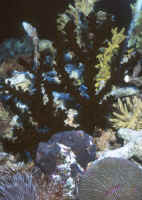 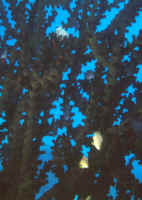
|
Bigger PIX:
The images in this table are
linked to large (desktop size) copies. Click on "framed"
images to go to the larger size. |
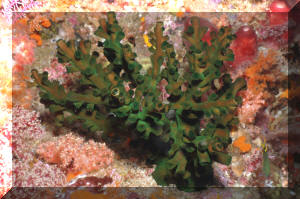
%20MD.JPG)
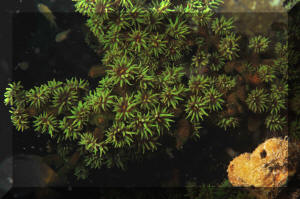
%20MD.JPG)
%20MD.JPG)
%20MD.JPG) |
Genus Turbinaria Oken 1815: /WA Corals: plates,
foliose or encrusting • corallites are 1-5mm diameter immersed or exsert •
coenosteum is smooth • well developed columellae
| Genus Turbinaria Oken : Form large colonies with mainly
laminar growth forms, common with several species. Round corallites
which are immersed to tubular in appearance. A commonly
offered and kept aquarium genus, whose members prove hardy amongst
a wide range of conditions. Being hermatypic and sponsors of
symbiotic algae, they do best in medium to bright (25k-50k lux)
light and brisk water movement. The thinner, more laminar species
and individuals (growth dependent on conditions...) are harder to
keep than the more fusiform members of the genus. |
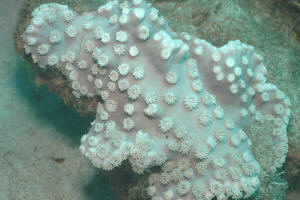
|
Bigger PIX:
The images in this table are
linked to large (desktop size) copies. Click on "framed"
images to go to the larger size. |
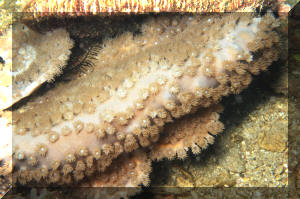 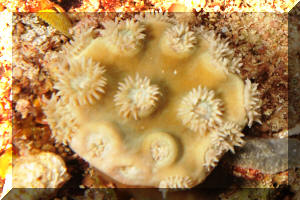 |
| Turbinaria frondens (Dana 1846), family
Dendrophylliidae is a newly popular, hardy stony coral for reef
tanks with good lighting and water quality. Frond-like plates with excise
cylindrical corallites. A spectacularly colored
specimen here (most are green to brown) in my friend Maurice
Bullock's main reef. |
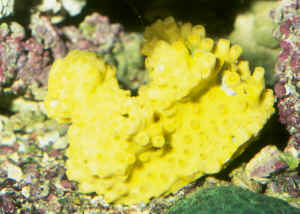
|
Bigger PIX:
The images in this table are linked
to large (desktop size) copies. Click on "framed" images
to go to the larger size. |
|
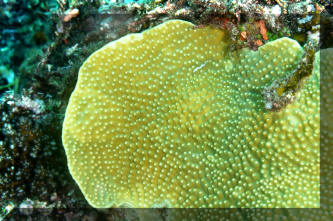
|
| Turbinaria heronensis, Queensland, Australia. |
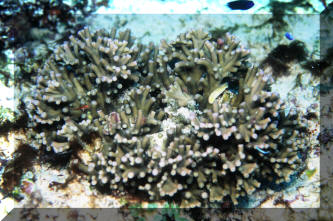 |
| Turbinaria mesenterina (Lamarck 1816).
Pagoda Coral to hobbyists, Bowl, Cup, Lettuce, Scroll Coral to the
trade. Indo-Pacific, Red Sea to Polynesia. Colonies laminar, more
convoluted in shallow waters to upright in deeper water (see
below). Corallites crowded, about 2.5 mm across, stick out further
than similar T. reniformis. Fiji images. |
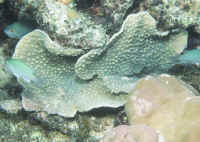
|
Bigger PIX:
The images in this table are linked to large
(desktop size) copies. Click on "framed" images to go to
the larger size. |
|
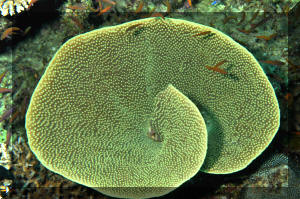
|
| Turbinaria patula Dana 1846. Colonies are
generally irregularly folded, upright, one-faced fronds. Corallites
of about 5mm diameter with elliptical, leaning-over openings.
Aquarium image. |
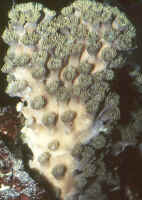
|
Part 1
Part 2,
Part 4
|
|

